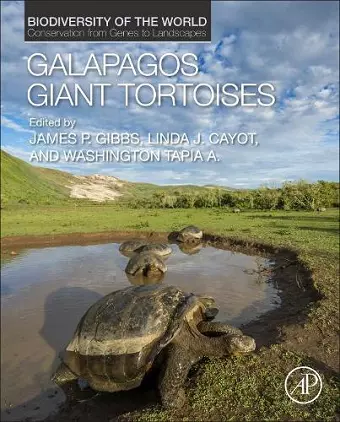Galapagos Giant Tortoises
James P Gibbs editor Linda J Cayot editor Washington Tapia A editor
Format:Hardback
Publisher:Elsevier Science Publishing Co Inc
Published:11th Nov '20
Should be back in stock very soon

Galapagos Giant Tortoises brings together researchers and conservationists to share the most up-to-date knowledge of Galapagos giant tortoises. Despite being icons of the world-famous Galapagos Archipelago and the target of more than 50 years of conservation research and management, Galapagos giant tortoise evolution and much of their ecology remained unknown until recently. This book documents the history, the pressing conservation issues, and success stories recovering several of the 15 different species of Galapagos tortoises from near extinction.The book begins with an overview of the history of the relationship between humans and Galapagos giant tortoises, starting from initial heavy exploitation of tortoises by pirates and whalers, and extending to the start of the modern conservation era in the 1960s. The book then shifts to biology, describing Galapagos tortoise evolution, taxonomy, ecology, habitats, reproduction, and behavior. Next the decades of conservation efforts and their results are reviewed, including issues of captive breeding, invasive species, introduced diseases, and de-extinction, as well as the current status and distribution of every species. The final portion of the book turns to four case studies of restoration, and then looks ahead to the future of all tortoise populations.The latest volume in the Biodiversity of the World: Conservation from Genes to Landscape series, Galapagos Giant Tortoises is a valuable resource for researchers and conservationists, as well as students of biology, wildlife conservation, and herpetology.
"I want to emphasize that this book is not just for Galápagos giant tortoise enthusiasts. It also highlights the many lessons that have been learned from restoration of Galápagos ecosystems. I teach an undergraduate course on conservation biology and always include a discussion of “ecological substitutes as a means or restoring lost ecological functions. The comprehensive list of tortoise rewilding efforts around the globe (Chapter 2) will definitely be incorporated into my discussion of this topic the next time I give the course. My course similarly includes a unit on eradication of invasive species, and the eradications successfully completed in the Galápagos (Chapter 19) are certainly a guide for future eradication attempts around the globe. I was particularly interested in the rat eradication carried out on Pinzón Island (Chapter 22) and the immediate benefits detected for not only Galápagos giant tortoises, but also land snails, lava lizards, Galápagos snakes, cactus finches, and Galápagos rails. This leads to my final point about the book’s inspiring accounts of individual tortoises. Although we are all aware of the incredible longevity of giant tortoises, the stories in this volume brought it home to me in a way I had not experienced before. I was particularly moved by the story of Diego (Chapter 21), the Española giant tortoise who was collected from his home island in 1934, spent 43 years at the San Diego Zoo, was then transferred to the Tortoise Breeding Center to participate in the captive breeding program for another 43 years, before being returned to his home island in 2020. It is incredible to think of any living organism having witnessed so much change, but the authors of this volume calculate that 2% of Galápagos giant tortoises alive today would have been present when Darwin visited the islands in 1834. It is only due to their extreme longevity that the tortoises were able to persist through centuries of human exploitation and invasive species (e.g., there was no natural tortoise recruitment on Pinzón for over a century). I commend the authors for composing engaging chapters across the board and the editors for forming them into a cohesive volume." --The Quarterly Review of Biology
ISBN: 9780128175545
Dimensions: unknown
Weight: 1650g
536 pages